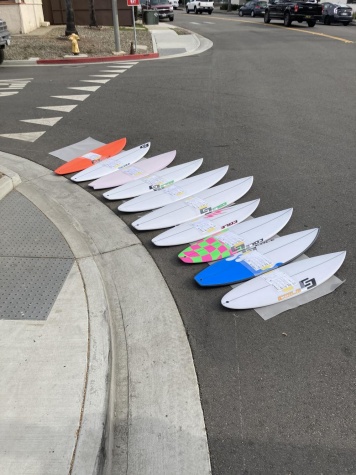
Owen Simler | Writer
February 26, 2021
The surfing industry is the backbone of San Clemente. Almost everyone is involved in the surfing industry in one way or another, but many people do not know that there are threats facing the surfing industry as it struggles to stay afloat.
One struggle with the surfing industry is that there are a lot of companies that are manufacturing and shipping their boards to the US for around $250, while it costs local shapers that much money just to receive a blank surfboard and to shape it. Local shapers put much more face-to-face time with each client to ensure the progression of surfing in this extraordinary sport, and this just isn’t possible to do with boards made in other countries.
“I’d rather have a $500 board from a local shaper because it is going to be a good investment and greater quality as opposed to a cheaply made one from China,” senior Stolie Erickson said. “Although a cheaper price is appealing, supporting small local businesses here in San Clemente is something I am fond of.”
Since the surfing industry is so small, it is nearly impossible that the US would issue a tariff or tax on imported surfboards. Surfboards are pouring in from other countries and all local shapers can do is just accept that this is a new reality.
“People should support local businesses and American-made products instead of imported products,” Cole Simler, the owner of Cole Surfboards said. “While these Chinese boards are bringing the general population into the surfing industry, they do not help the surfer progress which these locally shaped boards can do.”

The other issue with the surfing industry is that collectively, the surfing community turns its head to new surfers. The problem with this is that while many new surfers might be interested and intrigued with entering the surfing community, the surfing community might give them the cold shoulder.
Since the surfing community is unwilling to help, these surfers do not know enough about surfboards. This means that they don’t spend the extra money on a locally made surfboard that has the love and care from an experienced shaper. Instead, they choose the cheaper surfboard because they are not educated about what they are missing out on. While this board may look the same as a locally shaped one, the locally shaped one will always ride much better because the shaper has had much more experience creating surfboards.
When crafting a surfboard, there is no substitute for repetition and experience.
“I have ordered surfboards from local shapers and retail stores and I got much better service from my local shaper,” said Senior Kai Burleson. “They are much more helpful and informative than retail workers because I believe that they actually care.”
According to the Surf Industry Manufacturers Association, there are about 2.2 million people in the traditional “surfing community.” The study goes on to say there are 10.2 million people who enjoy surfing but are not able to surf as much as the “locals.”
Imagine if these 10 million people were educated about the process of crafting a surfboard and decided to support local businesses. The surf industry would boom, causing an explosion of new money so that these shapers and businesses would thrive. With this money, these shapers and business owners could pump this money back into their business causing local shapers to rule back on top once again.
“The only way that we are going to dig ourselves out of this hole is by educating the consumer about the importance of experience,” Shea Weber, a long-time local shaper who runs Dewey Weber Surfboards in the San Clemente surf ghetto said.“By doing this, these new surfers will understand and pay our higher prices in return for a better overall board.”
If there was a way for the surfing industry to communicate with this untapped potential of future surfers and explain to them why their surfboards are ten times better than the cheaper ones, the surfing industry would skyrocket and return to its former glory.

Leave a Reply